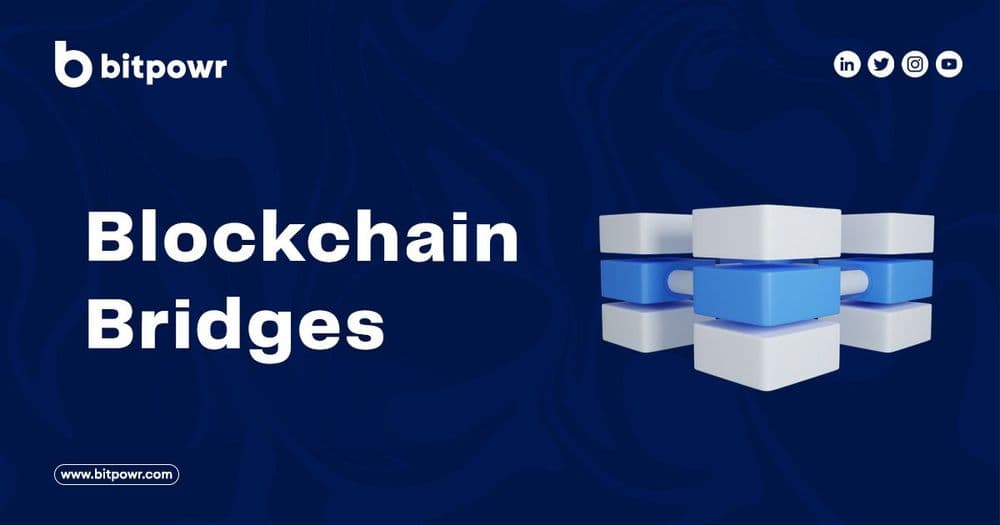Blockchain technology has revolutionized the way we think about transactions and data storage. However, each blockchain has its own standard and set of rules that are rarely compatible with other chains. This has led to a fragmented ecosystem where different blockchains operate in silos, unable to interact with each other. Blockchain bridges are a solution to this problem, allowing the transfer of tokens or data from one blockchain to another. In this article, we will explore what blockchain bridges are, how they work, their benefits, security challenges, and their future potential.
What are they
Blockchain bridges, also known as cross-chain bridges or interoperability protocols, are systems or technologies that enable the transfer of digital assets and data between different blockchain networks. These networks often have their own distinct protocols, consensus mechanisms, and native tokens. Blockchain bridges facilitate seamless communication and interaction between these diverse blockchains, enabling the exchange of value and information across previously isolated ecosystems.
The need for blockchain bridges arises from the fact that various blockchain platforms were developed independently and lacked a standardized way to communicate with one another. These bridges serve as connectors, allowing users to move assets, such as cryptocurrencies or tokens, from one blockchain to another while preserving security, transparency, and decentralization.
Blockchain bridges can take different forms and approaches, including:
- Wrapped Tokens: One blockchain’s native asset is “wrapped” or represented on another blockchain through a token that mirrors its value and properties. For instance, Bitcoin can be “wrapped” as an Ethereum-based token (WBTC).
- Decentralized Exchanges (DEXs): Certain decentralized exchanges use bridges to facilitate trading between tokens on different blockchains, effectively creating a cross-chain trading experience.
- Atomic Swaps: These allow for the direct exchange of assets between two different blockchains without the need for intermediaries.
- Multi-Chain Platforms: Some projects aim to create multi-chain platforms that host multiple blockchains in a single ecosystem, with built-in bridges to enable communication and asset transfers.
- Protocol Bridges: These bridges are often developed by blockchain projects themselves or by third-party developers to establish direct communication between two specific blockchains.
How Blockchain Bridges Work
Blockchain bridges work by connecting two or more blockchains, enabling users to transfer data and assets across different blockchains. They break down the dividing wall among different blockchain networks so they can interact efficiently. A bridge can take an asset on blockchain A and give the equivalent of the same asset on blockchain B. Blockchain bridges can be centralized or decentralized, and they can be unidirectional or bidirectional. Examples of blockchain bridges include Polygon, Binance Smart Chain, and Cosmos.
Types of Blockchain Bridges
Blockchain bridges can be centralized or decentralized. Centralized bridges are controlled by a single entity, while decentralized bridges are run by a network of nodes. Blockchain bridges can also be unidirectional or bidirectional. Unidirectional bridges allow you to port assets only to the target blockchain and not the other way around, while bidirectional bridges allow for the transfer of assets in both directions.
Benefits of blockchain bridges
Blockchain bridges offer several benefits, including increased interoperability, lower transaction costs, and faster processing times. By using a bridge, DApp developers can send their tokens onto another blockchain for processing at a higher speed and a lower cost. Blockchain bridges also offer more opportunities for development and innovation, as they allow developers to build on multiple blockchains simultaneously.
Security challenges of blockchain bridges
While blockchain bridges offer many benefits, they also come with their own security challenges. Bridge hacks take up to 50% of all the losses in crypto, so it is important to use secure bridges. Bridge developers must ensure that their bridges are secure to avoid security challenges.
The future of blockchain bridges
Blockchain bridges have the potential for further development and innovation. They can play a significant role in the growth of the Web3 ecosystem by facilitating communication and movement of assets between different blockchain networks. As the Web3 ecosystem continues to grow, blockchain bridges will become increasingly important.
Conclusion
Blockchain bridges are a solution to the limited interoperability that blockchain technology faces today. They allow the transfer of tokens or data from one blockchain to another, enabling interaction with another chain’s dApps and facilitating the connection of separate blockchains. Blockchain bridges can be centralized or decentralized, and they can be unidirectional or bidirectional. They offer better opportunities for increasing the number of users and more opportunities for the development and transfer of assets. However, bridge hacks take up to 50% of all the losses in crypto, so it is important to use secure bridges. Blockchain bridges can play a significant role in the growth of the Web3 ecosystem by facilitating communication and movement of assets between different blockchain networks.




